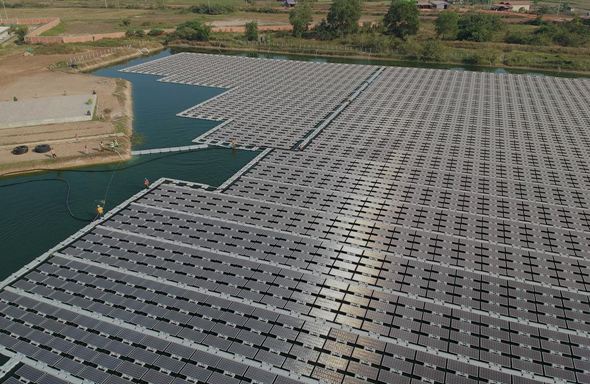Although located at different latitudes and on different continents, Cambodia and Lithuania now share the distinction of joining the list of nations that have embraced reservoir-based floating PV.
Singapore-based renewables company Cleantech Solar has announced the completion of a 9.8 MW solar installation that includes 2.8 MW of floating PV and will power Cambodian cement manufacturer Chip Mong Insee Cement Corporation (CMIC). The solar facility, Cleantech said, includes a 7 MW rooftop with the floating section on CMIC’s water reservoir.
The project was designed and financed by Cleantech and will sell power to the cement provider under undisclosed terms.
“The plant will help CMIC reduce operating costs without having to make [a] capital investment, nor having to take the performance risk of [a] solar system,” the developer said. “In addition, the deployment of the floating solar system will shield the reservoir from wind and the direct, hot midday sun, which is expected to reduce water loss through evaporation, contributing to CMIC’s water conservation efforts.”
Cambodia’s solar push
The reservoir section of the project is Cambodia’s first megawatt-sized floating PV installation. The country has so far seen limited development of solar power with a 10 MW solar park connected to its power network, although a 100 MW project is currently being tendered.
In October, the United Nations Development Program (UNDP) urged the Cambodian government to use solar to drive down electricity prices which are among the highest in Southeast Asia. “The government is on the verge of committing to an expansion of its hydropower program and coal plants, and this will limit the scope for solar development and potentially lead to additional social and environmental consequences,” the UNDP said at the time.
Last month, the Cambodian government issued new rules for the adoption of solar. The policy enables the installation of solar plants for self-consumption as long as they do not require grid connection and synchronization. The provisions also establish only medium and high voltage energy users are permitted to consume electricity generated on site and also be synchronized with the grid.
Popular content
Up to 250 MW of waterborne capacity
In a separate development, the Lietuvos Energija Gamyba (LEG) unit of state-owned Lithuanian utility Lietuvos Energija Group, announced the Lithuanian Business Support Agency has provided additional funding of €235,000 for its planned floating PV project at the Kruonis pumped storage hydroelectric power plant it owns.
The project, being developed with the Kaunas University of Technology, will be the first of its kind in Lithuania, LEG said in a press release.
The floating solar plant will initially have a capacity of 60 kW but may expand to 250 MW as the water surface identified by LEG for it runs to around 300 hectares. “The successful implementation of such [an] innovation would create greater value for Lietuvos Energija Gamyba shareholders and would contribute to the development of renewable resources in Lithuania, as the capacity of the currently installed solar power plants in Lithuania would increase three times,” said Darius Kucinas, production director for LEG.
According to the utility, the project is expected to be complete by 2021. The large-scale solar array will provide the hydropower plant with a reliable frequency control regulation service.
The utility unveiled its Strategy of Lietuvos Energija LE 2030 in May, a plan to increase renewable energy power production and pursue international development in neighboring countries. The strategy includes the development of high-tech energy storage capacity in power plants and solar is expected to represent more than a third of the group’s total installed renewable energy capacity by 2030, said LE – around 1.19 GW. Under the plan, wind and biofuels are set to reach 1.65 GW and 160 MW of capacity, respectively, and LEG also intends to acquire strategic power generation capacity abroad.
This content is protected by copyright and may not be reused. If you want to cooperate with us and would like to reuse some of our content, please contact: editors@pv-magazine.com.



What are the advantages to installing a floating solar array versus more traditional types of project?